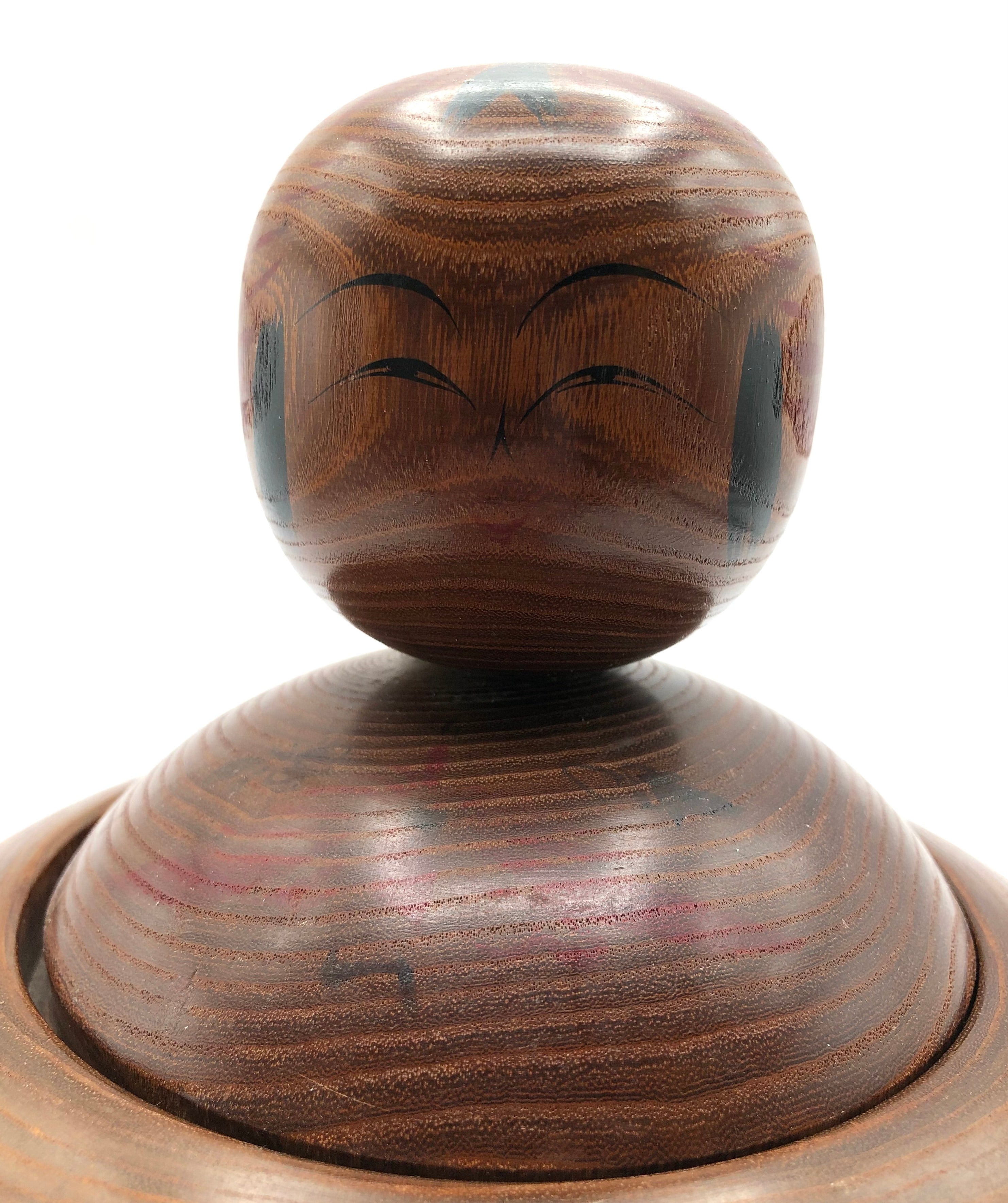


Vintage Japanese Traditional Tougatta Style Ejiko Kokeshi by Sato, Masahiro
Dimensions: 7-0”h x 7-1/2” dia
This Ejiko container is exceptional with the natural qualities of the wood emphasized with little ornamentation. The Japanese have always known that Pagoda trees were special and emphasized their natural qualities affording a durable and long-lasting artifact. As with this carving, the wood is composed of alternating natural colors of light brown to gray-brown throughout the wood. This makes a perfect Kokeshi or Ejiko made by carvers in both Sendai and Hokkaido, Japan.
This Ejiko has a perfect balance of polished and natural textured wood, stripped of its bark and hollowed out for holding children’s toys. It has a separate, upper part of the body acting as a lid, with a head in the style of the Tougatta Family. This part incorporates bangs and side hair fringes on both the top of the head. The face has narrow eyes and a small pick-shaped nose. The head on the top serves as a decorative grip for easy opening. The container has wide free-form shoulders and is decorated with a beautiful red chrysanthemum flower in the center. The piece is signed in script on the bottom by the artist Sato.
Condition: Excellent, perfect, original condition, with no fading or loss of color and consistent with age and standards of collectible Folk Art. All details are perfect and as crafted. A true collector's find.
NOTE: There is no biographical information published on the artist other than he was born in 1938 in the Miyagi prefecture and apprenticed with the Grand Masters Sato Tetsuro and Wagatsuma, Kichisuke.

Japanese Traditional Kokeshi
Tougatta-Kei (Family)
Prefecture: Miyagi
Origin:
Tougatta dolls are considered the oldest family members of the Traditional school. They originated in the Tougatta Onsen in the Miyagi Prefecture and were subsequently produced at Aone Onsen and the cities of Sendai and Izumi. In the 1960s, Togatta craftsmen founded the Tougatta Kiji Union, a cooperative that gained the rights for reserved wood use from the Japanese Ministry of Forestry. Collectors easily find the Tougatta style in an interesting range of variations.
Collector's note – characteristics/painting style:
Tougatta dolls are easily recognized by their narrow, columnar body shapes, tapering at the shoulders, to a head that is wider than the rest of the doll, and more angular than round. The head is a squeeze-in type, and it is covered with a painting of a chrysanthemum. Most Tougatta dolls have split bangs (Hachi), with side fringes, crescent-shaped double-lidded eyes (many of which have arched brows), and a split nose or cat-type nose. Several have paintings of chrysanthemums (Kiku), plums (Ume), and irises (Ayame), usually in very stylized designs. The dolls decorated with plum branches and blossoms are associated with Aone Onsen. There is also a group that has ‘banded’ bodies primarily in red with some green. These are decorated in a circular-style painting known as Rokoru Moyo, which is done as the doll is turned on the lathe. The most collectible type is the Tougatta Mokuma style, in which the body or kimono is intricately painted with a detailed and variable wood grain pattern.
NOTE: The rare Tougatta Yamiyo dolls are created with loose rings circling the waists. Carved from the same wood as the body- it is a very meticulous method! It is also seen on Yajirou and Tsuchiyu dolls, though just as rare.

Leading Craftsmen:
Agatsuma, Shozo, 1932- No additional published information
Saito, Ryosuke, 1925-2015 - No additional published information
Sato Fumio, 1923-1986. Lineage: Tougatta lineage Master: Sato Bunsuke Disciples: Sato Hidehiro / Kobayashi Sadao / Ohata Hideo. Born in Togatta-Shinchi as the eldest son of Sato Ushizo and Tamayo, woodworkers in Togatta-Shinchi. He trained in woodworking under Sato Bunsuke. In 1940 Sato-san learned how to turn kokeshi dolls and toys. Fumio was said to have both the Bunsuke and Ushizo characters inside him and was always caught in a conflict between his two mentors from the Tougatta and Hijiori families.
Sato, Bunkichi, 1922-2008 - No additional published information
Sato, Kouichi - No additional published information
Sato, Masairo, 1938- No additional published information
Sato, Nirio, 1948, (Tougatta, Miyagi) - Master: Sato, Teruo
Sato, Teruo, 1919 - (Tougatta) -Master: Sato Seisuke
Sato, Tomio - No additional published information
Sato, Yoshiaki, (Tougatta, Miyagi) - Master: Sato, Teruo
Sato, Ushizo , Master - (Tougatta, Miyagi Spa)
Nagao, Masayoshi, 1931-2001, (Sendai, Miyagi) - Master: Sato, Mamoru
Wagamatsu, Yoshio, 1932 (Aone, Miyagi) - Master: Wagatsuma, Kichisuke
Explore & Learn More about Tougatta-Kei (Family)